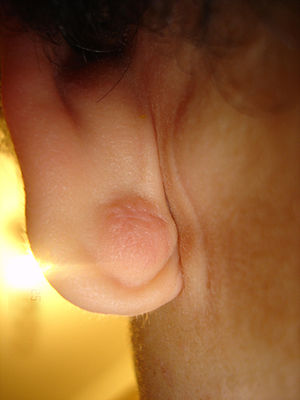Epidermoid cyst
| Epidermoid cyst | |
|---|---|
 |
|
| Epidermal cyst in the earlobe | |
| Classification and external resources | |
| Specialty | dermatology |
| ICD-10 | L72.0 |
| ICD-9-CM | 706.2 |
| OMIM | 131600 |
| DiseasesDB | 29388 |
| eMedicine | derm/860 |
| MeSH | D004814 |
An epidermoid cyst is a benign cyst usually found on the skin. The cyst develops out of ectodermal tissue. Histologically, it is made of a thin layer of squamous epithelium.
The epidermoid cyst may have no symptoms, or it may hurt when touched. It can release pus. It is very common for women on the major or minor labia. In contrast to pilar cysts, epidermoid cysts are usually present on parts of the body with relatively little hair.
Occasionally, an epidermoid cyst will present with Trigeminal neuralgia.
Although they are not malignant, there are rare cases of malignant tumors arising from an epidermoid cyst.
Epidermoid cysts commonly result from implantation of epidermis into the dermis, as in trauma or surgery. They can also be caused by a blocked pore adjacent to a body piercing. They are also seen in Gardner's syndrome and Nevoid Basal Cell Carcinoma Syndrome on the head and neck. They can be infected by bacteria and form a pimple-like shape.
Epidermoid cysts are usually diagnosed when a person notices a bump on their skin and seeks medical attention. The definitive diagnosis is made after excision by a pathologist based on microscopic appearance of a cystic lesion lined by cornified epithelium containing lamellated keratin without calcifications. They can also be seen as isointense lesions on MRI or hyperintensities on FLAIR.
...
Wikipedia
